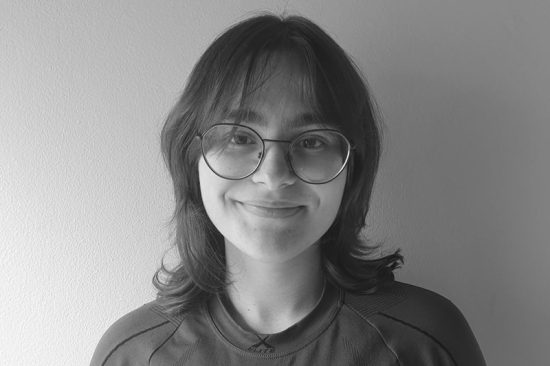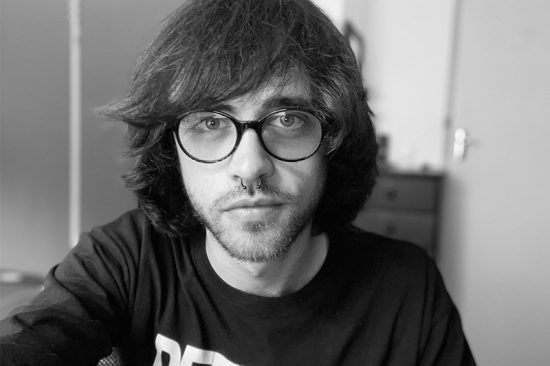
Lily Taggart is a visual and performing artist based in New York City. She utilizes her experience in performance to create dynamic designs focused on turning the ephemeral into something tangible. Her interdisciplinary approach to art and design can be seen across the many mediums Taggart finds herself working in. From immersive installations to marketing campaigns to production design, she continues to push the boundaries of what is possible through her work. Lily is currently a student at The New School where she is enrolled in the dual degree program, seeking a BFA in Integrated Design and BA in Theatre.
“Every time I look at the list of all of them [the gates] and then see the artist’s gate, I’m like—yes, this one, this is why I’m here doing this, and I need to be doing this.”
TPP45S Of the forty-five visuals you created, which is your favorite? Why?
LILY TAGGART Oh, I mean, I feel like the aesthetic [of the symbols] is pretty similar, but I think the artist’s gate is my favorite. This project especially was a really important realization for me and my artistic practice.
I’m studying graphic design and that can become a very commercialized thing. But this project, even though it’s very graphic, I see it more as an art work than as a design piece per se. It made me realize that it’s really important for me to do conceptual work. Every time I look at the list of all of them [the gates] and then see the artist’s gate, I’m like—yes, this one, this is why I’m here doing this, and I need to be doing this.

TPP45S What was your initial response looking at the Phaistos Disc?
LILY TAGGART I’ve always been really interested in the way that people are able to interact with each other across different cultures without written language, and I think this [the Phaistos Disc] is a perfect example of that and this kind of human desire to connect in a way beyond verbalization. And since I do have training and experience as a performing artist, the way I know how to do that [communicate non-verbally] is through physical movement. But the Phaistos Disc did it visually. I think this project’s jumping off point was thinking about how to merge those two ideas together.
TPP45S Why do you think an artifact from the past could be relevant to you and your creative practice?
LILY TAGGART I feel like I’m pulling from archives all the time. I’m very inspired by things that came before me. I think there’s a lot to learn—this goes back to this idea that I just mentioned about how I’m really fascinated with the human condition. I like to look back at things from the past to see what we were doing across cultures before we were so interconnected and understand what things still brought us together [and fundamentally connected us]. I think that can help us get to the root of what it means to be human. This disc is a perfect example of that.

TPP45S Your winning piece Dialectic Dancescape turns the fluidity of Central Park’s suggested paths into dance choreography. You, yourself, are a dancer. Did your background affect the way you approached designing this project?
LILY TAGGART Definitely. I think a lot of my art practice is rooted in bridging my work as a performing and visual artist.
[For this project] I was using pre-existing, defined paths [in Central Park] but the ways that I ordered and sequenced them as choreography was a very impulsive process, which I feel is very reflective of how I work as a dancer. What I enjoy as a performer is that sort of spontaneity—that every time you do it, it could be different.
TPP45S What does your project tell audiences of today and tomorrow about our current anthropocene and human impact on our planet
LILY TAGGART I don’t know if this is necessarily a shared experience, but I have had so many times where I’ve been in that park and run into people that I know completely randomly. And I’m just like, “How in this massive city in this massive park, are we able to connect this way?” and it feels like the natural landscape—it has to be something to do with that. And then there’s the days when it’s really beautiful in New York and you go to the park and these masses of people come together, which creates all these opportunities for chance encounters. So I think [the project tells us] about our [current] relationship with the earth and how we communicate with it and how it’s such an essential part of being able to connect with people in real space.
TPP45S In Dialectic Dancescape, the names of Central Park’s official gates are included among the forty-five symbols. But you came up with titles of the other twenty-five gates with a focus on representing “previously unrecognized individuals.” For example, you dubbed one symbol the “Gate of the Exhausted” and another the “Gate of the Struggling.” Why did you choose the names you did for each of these gates?
LILY TAGGART The park was created to be a democratic space. That was why they [Central Park’s creators] named the gates what they did, because they didn’t want them to be named after political figures. If they were, then it’d seemed like the park was for the elites.
I think knowing that was the intention with the original gates—some of the original ones were things like merchants or artisans—I pulled on that and then started thinking, okay, now we’re jumping 150 years after those first gates were created, who now exists that deserves that same sort of recognition? Who are people today that I see in the park? So just trying to follow that same vein of it’s a very democratic space meant for everyone to enjoy regardless of where they come from. And I think I look at dance that way. It’s also an opportunity for people regardless of where they come from, to express themselves in very different ways.
TPP45S Could you describe how you imagine someone dancing the choreography of Dialectic Dancescape’s forty-five symbols?
LILY TAGGART What I’m really interested in is the unexpected, and so I think when I think about people dancing this—freedom is probably the biggest word that just comes to mind. I think freedom and then also history, in terms of personal history, all of these sorts of perspectives and contexts that you carry with you in your life—carrying that with you and then seeing what that looks like embodied in a new space [while dancing].
I don’t think there’s any specific movement base that I’d be excited to see. I think I’d be excited to see a lot of different people doing the same sort of sequence because that is what I’m most interested in when thinking about choreographic notation—how different a dance can be from person to person, even if they’re following the same set of instructions.

TPP45S Your work focuses on how movement and fluidity in design are the key to its evolution. How do you feel design will be influenced by movement in the future?
LILY TAGGART I think there could be more. I also work doing commercial branding for theatrical performances. And I always get frustrated in those spaces because to me, there’s such a clear pipeline between movements and visuals because you’re promoting a movement driven piece—so you should make them, the visuals, very interactive. And oftentimes, they’re pretty standard playbills, which are just a flip book.
So I think they’re seen as separate things. But I don’t think they should be at all.
TPP45S What do you believe are the biggest challenges of this upcoming generation of visual artists/designers?
LILY TAGGART I’m trying to think about [the biggest challenges] for me—I would hate to generalize. This is a tricky question. I think there’s a lot of different things that I grapple with as a designer. I think for me personally right now—and I talked a little about this—bridging the gap between art and design is a big challenge. I was speaking about how visual arts and performance are seen as very separate and I think we’re also in a place where those two things [art and design] are also seen as very separate.
And this is the thing that I loved about doing this project—I was able to merge design and art together, but I think that’s not always what people are promoted to do. For example, when talking to my friends in school they say “I want to be making art, but I also want to design things, but how do I do both and what does that look like and will people like it if I do both?” But then you also see so many designers that have a more artistic practice on the side that’s fulfilling and needed to drive their design process.
TPP45S The humans who created the Phaistos Disc—if it’s not a hoax—will never be able to tell us what its forty-five symbols mean. But you are here with us today, to talk about your own set of forty-five symbols. What is it that you hope people take away from your project?
LILY TAGGART I hope people take away the importance of movement as a means of connection. That people can look at it [the project] and ponder how they would embody the choreography, what they would do with that freedom, and how their version of it would differ from others’. Yes, it [the choreography] is written down somewhere, but every time it’s performed or looked at it changes in some way.

Lily Taggart
Lily Taggart is a visual and performing artist based in New York City. She utilizes her experience in performance to create dynamic designs focused on turning the ephemeral into something tangible. Her interdisciplinary approach to art and design can be seen across the many mediums Taggart finds herself working in. From immersive installations to marketing campaigns to production design, she continues to push the boundaries of what is possible through her work. Taggart is currently a student at The New School where she is enrolled in the dual degree program, seeking a BFA in Integrated Design and BA in Theatre.
Dialectic Dancescape
Winning Project Open Call 22/23



